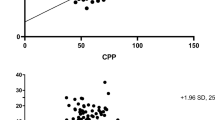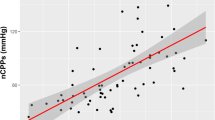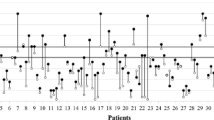Abstract
Purpose
The purpose of this study is to evaluate the accuracy of emergency Transcranial Doppler (TCD) to predict intracranial hypertension and abnormal cerebral perfusion pressure in children with severe traumatic brain injury (TBI).
Patients and methods
A descriptive and retrospective cross-sectional study was designed through data collected from medical records of children with severe TBI (Glasgow coma scale ≤8), admitted to a level I pediatric trauma center, between January 2000 and December 2005. Early TCD examination was performed upon admission, and TCD profiles were considered as altered using previously validated threshold values for diastolic velocity (<25 cm/s) and pulsatility index (>1.31) or when no-flow/backflow was detected. Invasive intracranial pressure (ICP) and cerebral perfusion pressure (CPP) monitoring were considered as the gold standard to measure intracranial hypertension (ICH). Statistical analyses compared TCD profiles to increased ICP (≥20 mmHg) and abnormal cerebral perfusion pressure (<50 mmHg) at admission.
Results
Non-invasive TCD and ICP monitoring were performed in 117 severe head-injured children. Mean age was 7.6 ± 4.4 years, with a male prevalence (71%). Median initial Glasgow coma scale was 6. TCD had 94% of sensitivity to identify ICH at admission and a negative predict value of 95% to identify normal ICP at admission. Its sensitivity to predict abnormal cerebral perfusion pressure was 80%.
Conclusions
The high sensitivity of admission TCD to predict ICH and abnormal CPP after trauma demonstrates that TCD is an excellent first-line examination to determine those children who need urgent aggressive treatment and continuous invasive ICP monitoring.
Similar content being viewed by others
References
Anderson VA, Catroppa C, Haritou F, Morse S, Pentland L, Rosenfeld J, Stargatt R (2001) Predictors of acute child and family outcome following traumatic brain injury in children. Pediatr Neurosurg 34:138–348
Chiaretti A, Piastra M, Pulitano S, Pietrini D, De Rosa G, Barbaro R, Di Rocco C (2002) Prognostic factors and outcome of children with severe head injury: an 8-year experience. Childs Nerv Syst 18:129–136
Melo JRT, Silva RA, Moreira ED Jr (2004) Characteristics of patients with head injury at Salvador City (Bahia-Brazil). Arq Neuropsiquiatr 62:711–714
Melo JRT, de Santana DL, Pereira JL, Ribeiro TF (2006) Traumatic brain injury in children and adolescents at Salvador City, Bahia, Brazil. Arq Neuropsiquiatr 64:994–996
Meyer P, Legros C, Orliaguet G (1999) Critical care management of neurotrauma in children: new trends and perspectives. Childs Nerv Syst 15:732–739
Orliaguet GA, Meyer PG, Blanot S, Jarreau MM, Charron B, Buisson C, Carli PA (1998) Predictive factors of outcome in severely traumatized children. Anesth Analg 87:537–542
Orliaguet GA, Meyer PG, Baugnon T (2008) Management of critically ill children with traumatic brain injury. Paediatr Anaesth 18:455–461
Ricard-Hibon A, Marty J (2000) Management of severe head-injured patients in the first 24 h. Resuscitation and initial diagnostic strategy. Ann Fr Anesth Rèanim 19:286–295
Ter MA, Dube L, Guilleux AM, Wehrmann N, Ursino M, Beydon L (2002) Changes in intracranial pressure and cerebral autoregulation in patients with severe traumatic brain injury. Crit Care Med 30:1616–1622
Bellner J, Romner B, Reinstrup P, Kristiansson KA, Ryding E, Brandt L (2005) Transcranial Doppler reflects intracranial pressure. Lakartidningen 102:840–841
Meyer PG, Ducrocq S, Carli P (2001) Pediatric neurologic emergencies. Curr Opin Crit Care 7:81–87
Ng SC, Poon WS, Chan MT (2006) Cerebral hemisphere asymmetry in cerebrovascular regulation in ventilated traumatic brain injury. Acta Neurochir Suppl 96:21–23
Safin AM, Mandorskii SV, Parfenov AL, Oshorov AV (2007) Cerebral circulatory disorders in varying brain injury, as evidenced by transcranial Doppler study. Zh Vopr Neirokhir Im N N Burdenko 2:16–20
Trabold F, Meyer PG, Blanot S, Carli PA, Orliaguet GA (2004) The prognostic value of transcranial Doppler studies in children with moderate and severe head injury. Intensive Care Med 30:108–112
Visocchi M (2008) Hyper flow and intracranial hypertension in diffuse axonal injury: an update to gennarelli doctrine. Acta Neurochir Suppl 101:137–140
Philip S, Chaiwat O, Udomphorn Y, Moore A, Zimmerman JJ, Armstead W, Vavilala MS (2009) Variation in cerebral blood flow velocity with cerebral perfusion pressure >40 mm Hg in 42 children with severe traumatic brain injury. Crit Care Med 37:2973–2978
Vavilala MS, Lee LA, Boddu K, Visco E, Newell DW, Zimmerman JJ, Lam AM (2004) Cerebral autoregulation in pediatric traumatic brain injury. Pediatr Crit Care Med 5:257–263
Meyer PG, Ducrocq S, Rackelbom T, Orliaguet G, Renier D, Carli P (2005) Surgical evacuation of acute subdural hematoma improves cerebral hemodynamics in children: a transcranial Doppler evaluation. Childs Nerv Syst 21:133–137
Udomphorn Y, Armstead WM, Vavilala MS (2008) Cerebral blood flow and autoregulation after pediatric traumatic brain injury. Pediatr Neurol 38:225–234
Trabold F, Meyer P, Orliaguet G (2002) Severe head injuries in the young child: early management. Ann Fr Anesth Rèanim 21:141–147
Grinkeviciute DE, Kevalas R, Matukevicius A, Ragaisis V, Tamasauskas A (2008) Significance of intracranial pressure and cerebral perfusion pressure in severe pediatric traumatic brain injury. Medicina (Kaunas) 44:119–125
Nordstrom CH, Reinstrup P, Xu W, Gardenfors A, Ungerstedt U (2003) Assessment of the lower limit for cerebral perfusion pressure in severe head injuries by bedside monitoring of regional energy metabolism. Anesthesiology 98:809–814
Bardella IJ (1999) Pediatric advanced life support: a review of the AHA recommendations. American Heart Association. Am Fam Physician 60:1743–1750
Sviri GE, Newell DW, Lewis DH, Douville C, Ghodke B, Chowdhary M, Lam AM, Haynor D, Zaaroor M, Britz GW (2006) Impact of basilar artery vasospasm on outcome in patients with severe cerebral vasospasm after aneurysmal subarachnoid hemorrhage. Stroke 37:2738–2743
Takahashi K, Hayashi S, Ootani T, Sera M, Negishi M (2008) Dural arteriovenous fistula manifesting as subarachnoid hemorrhage at the craniocervical junction. A case report. No Shinkei Geka 36:901–906
Jesus PA, Vieira-de-Melo RM, Reis FJ, Viana LC, Lacerda A, Dias JS, Oliveira-Filho J (2006) Cognitive dysfunction in congestive heart failure: transcranial Doppler evidence of microembolic etiology. Arq Neuropsiquiatr 64:207–210
Oliveira-Filho J, Ezzeddine MA, Segal AZ, Buonanno FS, Chang Y, Ogilvy CS, Rordorf G, Schwamm LH, Koroshetz WJ, McDonald CT (2001) Fever in subarachnoid hemorrhage: relationship to vasospasm and outcome. Neurology 56:1299–1304
Czosnyka M, Czosnyka Z, Keong N, Lavinio A, Smielewski P, Momjian S, Schmidt EA, Petrella G, Owler B, Pickard JD (2007) Pulse pressure waveform in hydrocephalus: what it is and what it isn’t. Neurosurg Focus 22:E2
Riggo JD, Kolarovszki B, Richterova R, Kolarovszka H, Sutovsky J, Durdikc P (2007) Measurement of the blood flow velocity in the pericallosal artery of children with hydrocephalus by transcranial Doppler ultrasonography—preliminary results. Biomed Pap Med Fac Univ Palacky Olomouc Czech Repub 151:285–289
Rodriguez-Nunez A, Somoza-Martin M, Gomez-Lado C, Eiris-Punal J, Camina-Darriba F, Rodriguez-Segade S, Castro-Gago M (2008) Therapeutic criteria in communicating childhood hydrocephalus. J Neurosurg Sci 52:17–21
Ducrocq SC, Meyer PG, Orliaguet GA, Blanot S, Laurent-Vannier A, Renier D, Carli PA (2006) Epidemiology and early predictive factors of mortality and outcome in children with traumatic severe brain injury: experience of a French pediatric trauma center. Pediatr Crit Care Med 7:461–467
Javouhey E, Guerin AC, Martin JL, Floret D, Chiron M (2009) Management of severely injured children in road accidents in France: impact of the acute care organization on the outcome. Pediatr Crit Care Med 10:472–478
Bekar A, Taskapilioglu O, Yilmazlar S, Ender K, Aksoy K (2008) Is supratentorial pressure difference clinically relevant? Analysis of 55 consecutive cases by bilateral intracranial pressure monitoring. Neurol Res 30:465–470
Bekar A, Dogan S, Abas F, Caner B, Korfali G, Kocaeli H, Yilmazlar S, Korfali E (2009) Risk factors and complications of intracranial pressure monitoring with a fiberoptic device. J Clin Neurosci 16:236–240
Chambers IR, Treadwell L, Mendelow AD (2001) Determination of threshold levels of cerebral perfusion pressure and intracranial pressure in severe head injury by using receiver-operating characteristic curves: an observational study in 291 patients. J Neurosurg 94:412–416
Chambers IR, Jones PA, Lo TY, Forsyth RJ, Fulton B, Andrews PJ, Mendelow AD, Minns RA (2006) Critical thresholds of intracranial pressure and cerebral perfusion pressure related to age in paediatric head injury. J Neurol Neurosurg Psychiatry 77:234–240
Figaji AA, Zwane E, Fieggen AG, Siesjo P, Peter JC (2009) Transcranial Doppler pulsatility index is not a reliable indicator of intracranial pressure in children with severe traumatic brain injury. Surg Neurol 72:389–394
Visocchi M, Chiaretti A, Genovese O, Di Rocco F (2007) Haemodynamic patterns in children with posttraumatic diffuse brain swelling. A preliminary study in 6 cases with neuroradiological features consistent with diffuse axonal injury. Acta Neurochir (Wien) 149:347–356
Murillo-Cabezas F, Arteta-Arteta D, Flores-Cordero JM, Munoz-Sanchez MA, Rincon-Ferrari MD, Rivera-Fernandez MV, Alacron-Cruz JC (2002) The usefulness of transcranial Doppler ultrasonography in the early phase of head injury. Neurocirugia (Astur) 13:196–208
Muttaqin Z, Uozumi T, Kuwabara S, Arita K, Kurisu K, Ohba S, Kohno Ogasawara H, Ohtani M, Mikami T (1993) Hyperaemia prior to acute cerebral swelling in severe head injuries: the role of transcranial Doppler monitoring. Acta Neurochir (Wien) 123:76–81
Hindy-Francois C, Orliaguet G, Meyer P, Carli P, Blanot S, Hertz-Pannier L, Brunelle F (2009) Pediatric brain death diagnosis in the view of organ donation in France. Transplantation 87:616–617
Acknowledgement
CAPES-Brazil (Coordenação de Aperfeiçoamento de Pessoal de Nível Superior) funded Jose Roberto Tude Melo’s studies abroad.
Conflict of Interest
None.
Author information
Authors and Affiliations
Corresponding author
Rights and permissions
About this article
Cite this article
Melo, J.R.T., Di Rocco, F., Blanot, S. et al. Transcranial Doppler can predict intracranial hypertension in children with severe traumatic brain injuries. Childs Nerv Syst 27, 979–984 (2011). https://doi.org/10.1007/s00381-010-1367-8
Received:
Accepted:
Published:
Issue Date:
DOI: https://doi.org/10.1007/s00381-010-1367-8




